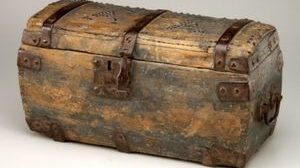Some people call them hope chests or bottom drawers. My mother calls them glory boxes. In Western cultures, they are places where little girls store their trouseaux — linens and other items they have made — in preparation for marriage.
Before factory-made textiles, making fabrics took up such enormous amounts of female time that little girls had to start preparing for wifehood as soon as their fine motor control came in.

Any spare minute women and girls had, their hands were busy spinning plant fibres (flax, hemp, cotton) and animal hair (sheep, goat, horse) into thread, weaving thread into fabrics, sewing fabrics into useful shapes, and decorating special items with needlepoint, lace, embroidery and braiding.
My grandmother’s grandmother Alphonsine was born in Québec in 1875 and used a wooden chest to store her trouseau. Bringing an ancient tradition from Europe, Québeckers built their daughters’ hope chests of cedarwood. The oil in the wood helped protect precious cloth by repelling moths, which like to eat processed fibres.
The wood of cedar trees has been used for storage boxes for literal millennia because of its oil’s lavicidal properties. The practice began, as most things did, in the Levant. The first civilisations of modern-day Lebanon, Syria, Iraq, Palestine, and Jordan used it to construct cities, build ships, make paper and furniture, and as a valuable tradable item in the international economy. The use of cedarwood spread to Egypt where its oil became essential to the craft of the ancient embalmers. In the mid-1500s France caught up and began using it for storage boxes and decoration.
In the early 1600s, French settlers found familiar-looking trees on the lands of the Haudenosaunee on the eastern coast of present-day Quebec. The French used the American trees in the same ways they had at home, not realising that they are a different species. Luckily for them, the oil of the eastern red cedar also repels insects.
The Haudenoshaunee have always made far more use of the cedars than did my ancestors. As well as protecting against bugs, they use its oil for its anti‑fungal properties that treat skin infections; tea made from its twigs can ease pain, a preparation from several parts of the plant induces abortions, a layer of the bark is good for weaving baskets and mats, and the wood works well as roof shingles and for lining birch bark canoes and insulating houses. In the most-spoken Haudenoshaunee language, Kanienkeha, cedar is onen’takwenhténhtshera.

Almost all of Québec’s initial French settlers were men. For 30 years they traded furs, massacres, and syphilis with the Haudenosaunee and barely survived the brutally cold eight-month winters. Finally, they convinced someone in Louis XIV’s Government to help the colony grow. Starting in 1662, France incentivised emigration to “New France” for unmarried young women.
Sent by the King for the good of the Empire, they were called the Filles du Roi. The youngest were 15 years old, the oldest 25. All were either unmarried or widowed. Some brought their children. Fulfilling his contractual paternal role, Louis XIV bestowed on each of les Filles a trousseau, apparently in chests like the single surviving artefact below. To the settlers who married them, the King gave dowries of up to 500 livres.
The royally provided hope chests contained a household money box and two livres in silver coin, some “ordinary clothing”, and lots of textile-oriented items: a hood, a taffeta kerchief, shoe ribbons, 100 sewing needles, a comb, white thread, a pair of stockings, a pair of gloves, a pair of scissors, two knives, 1,000 pins, a bonnet, and four braids. Another government funding body gave them some clothing to suit the climate (probably snow-oriented), cash for household sundries, and bits and pieces from the King’s Stores, which were government warehouses in Québec where the colonists stored essentials like wheat, wine and weapons.
After a couple of centuries of wars with Haudensaunee, British, and Americans, my great-great-grand-mère Alphonsine began preparing for marriage and motherhood: spinning, weaving, knitting, stitching. She stored her creations in the cedar chest made by her father or brother or uncle, earnestly, blithely layering within the timber all her hopes and plans for the future.

